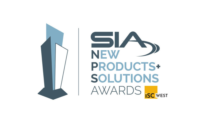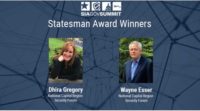The Security Industry Association presented the first part of the 2021 SIA GovSummit, its annual public policy and government security technology conference, on Wednesday, April 28.
The 2021 virtual three-part conference will examine emerging policy trends, the government’s technology needs and changes in the risk environment that shape the development of products and advanced systems integration. In this portion, biometric, touchless solutions and the storming of the U.S. Capitol on Jan. 6 were popular topics mentioned frequently throughout the all-day summit.
The day started with opening remarks from U.S. Rep. John Katko (R-N.Y.), ranking member of the House Committee on Homeland Security. In a pre-recorded speech shared with the virtual audience, Katko emphasized bipartisanship, noting his focus on cultivating positive partnerships with congressional Democrats and Homeland Security officials.
“Chairman Bennie Thompson [D-Miss.] and I have already begun funding ground and are enjoying an excellent relationship, particularly on cybersecurity issues, and hope we can continue working together in a bipartisan way,” Katko said.
Additionally, Katko discussed the return to travel and the importance of cybersecurity amidst major attacks, including a recent incident at a water treatment facility in Oldsmar, Fla. and the 2020 SolarWinds hack.
“The bottom line is, we live in a system of systems world, where an interconnected web of hardware, software and services underpin almost every aspect of our lives,” Katko said.
Immediately following Katko’s remarks, which clocked in at around 10 minutes, the first panel of the day “The American Rescue Plan Act, Infrastructure Modernization and the Role of Safety and Security Solutions,” discussed how security professionals can help with post-COVID-19 economic recovery. The panel featured David Klug, Convergint Technologies; Jake Parker, SIA; Dominic Sorrentino, Motorola Solutions; and John Mulligan, Monument Advocacy.
Schools receiving CARES funds took up a large portion of the conversation, since most are now required to update or include security systems in the building.
“That’s why it’s important to talk about infrastructure in this context, as many of the recipients will be looking to do many different types of project with the funding,” said Jake Parker, senior director of government relations at SIA.
David Klug, who works on strategic business development at Convergint Technologies, pointed out that the physical security industry can come in and help multiple government industries since CARES money can be used to adopt video analytics and biometric solutions that can enforce social distancing or provide thermal protection.
“We've seen funds spent on specific COVID-related technologies, things like thermal detection at departments of corrections, contactless biometric access control in schools, aviation, local government,” Klug said. “We've seen the purchase, for example of additional security cameras in polling places to help with accurate occupancy detection.”
“Protecting Public Buildings from Civil Unrest,” discussed how to plan for and protect against potential violence due to civil unrest. Here, the Portland protests and the Capitol siege were used as examples of what the current threat environment looks like.
“We're experiencing things such as our CCTV cameras coming under constant attack with people spray painting them to obscure them so they can conduct other attacks, striking them with hammers, shooting at them with paintball guns, trying to blind them with lasers,” Gabriel Russell, regional director with the Department of Homeland Security’s Federal Protective Service. “We are constantly you having to kind of adapt and evolve, moving the cameras up higher or develop better camera housings for them.”
“Facility Safety, COVID-19 and the Growing Role of Identity and Facility Management Technologies” explored best practices and technologies that are being implemented for occupancy management, reducing touch points and more.
With more offices setting up return to work plans and more people getting vaccinated, Jeff Nigriny, CEO of Certipath, pointed out that the largest liability for building and facility management is unvaccinated people.
“I think at this point, if you have people coming back and they aren't vaccinated, you’ve got to be seriously thinking about keeping the list of who is and who isn’t. And I know that's not popular, but you’ve got to remember why you're doing this in the first place. I can feel the virtual tomatoes, but I'm going to leave it at that.”
In “How Audio Security Technologies Complement and Manage High-Risk Scenarios in Government Facilities,” the final presentation of the day, each presenter gave a brief presentation on how their company uses audio.
Richard Brent, CEO of Louroe Electronics, opened the presentation with a powerful, succinct statement that showed the importance of verifying video using audio.
“Before I go any further, I'm hoping that everybody here is listening,” said Richard Brent. “Because in this industry, we don't do enough listening. We do a lot of eyeballing. But we don't necessarily know when the eyeballs are focused. … Verification of video is critically important.”
The next portions of the GovSummit are set for June 9 and Sept. 21, respectively. Visit the SIA website for more information regarding the SIA GovSummit.



